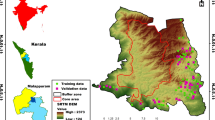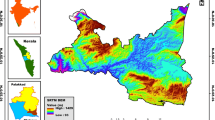Abstract
A comparative study of Frequency Ratio (FR) and Analytic Hierarchy Process (AHP) models are performed for forest fire risk (FFR) mapping in Melghat Tiger Reserve forest, central India. Identification of FFR depends on various hydrometeorological parameters (altitude, slope, aspect, topographic position index, normalized differential vegetation index, rainfall, air temperature, land surface temperature, wind speed, distance to settlements, and distance by road are integrated using a GIS platform. The results from FR and AHP show similar trends. The FR model was significantly higher accurate (overall accuracy of 81.3%, kappa statistic 0.78) than the AHP model (overall accuracy 79.3%, kappa statistic 0.75). The FR model total forest fire risk areas were classified into five classes: very low (7.1%), low (22.2%), moderate (32.3%), high (26.9%), and very high (11.5%). The AHP fire risk classes were very low (6.7%), low (21.7%), moderate (34.0%), high (26.7%), and very high (10.9%). Sensitivity analyses were performed for AHP and FR models. The results of the two different models are compared and justified concerning the forest fire sample points (Forest Survey of India) and burn images (2010–2016). These results help in designing more effective fire management plans to improve the allocation of resources across a landscape framework.










Similar content being viewed by others
References
Adab H, Kanniah KD, Solaimani K (2013) Modeling forest fire risk in the northeast of Iran using remote sensing and GIS techniques. Nat Hazards 65(3):1723–1743
Agee JK (1998) The landscape ecology of western forest fire regimes. Northwest Sci 72:24
Chen Y, Yu J, Khan S (2010) Spatial sensitivity analysis of multi-criteria weights in GIS-based land suitability evaluation. Environ Model Softw 25(12):1582–1591
Chuvieco E, Congalton RG (1988) Mapping and inventory of forest fires from digital processing of TM data. Geocarto Int 3(4):41–53
Chuvieco E, Congalton RG (1989) Application of remote sensing and geographic information systems to forest fire hazard mapping. Remote Sens Environ 29(2):147–159
Chuvieco E, Aguado I, Cocero D, Riaño D (2003) Design of an empirical index to estimate fuel moisture content from NOAA-AVHRR images in forest fire danger studies. Int J Remote Sens 24(8):1621–1637
Clark JS (1990) Fire and climate change during the last 750 yr in northwestern Minnesota. Ecol Monogr 60(2):135–159
Cortez P, Morais ADJR (2007) A data mining approach to predict forest fires using meteorological data
Dhar A, Sahoo S, Sahoo M (2015) Identification of groundwater potential zones considering water quality aspect. Environ Earth Sci 74(7):5663–5675
Erten E, Kurgun V, Musaoglu N (2004) Forest fire risk zone mapping from satellite imagery and GIS: a case study. In: 20th Congress of the international society for photogrammetry and remote sensing, Istanbul, Turkey, pp 222–230
Flannigan M, Campbell I, Wotton M, Carcaillet C, Richard P, Bergeron Y (2001) Future fire in Canada’s boreal forest: paleoecology results and general circulation model-regional climate model simulations. Can J For Res 31(5):854–864
Harker PT, Vargas LG (1990) Reply to “remarks on the analytic hierarchy process” by JS Dyer. Manage Sci 36(3):269–273
Herrera GV (2016) Mexican forest fires and their decadal variations. Adv Space Res 58(10):2104–2115
Kant Sharma L, Kanga S, Singh Nathawat M, Sinha S, Chandra Pandey P (2012) Fuzzy AHP for forest fire risk modeling. Disaster Prev Manag 21(2):160–171
Kayet N, Pathak K, Chakrabarty A, Sahoo S (2016a) Spatial impact of land use/land cover change on surface temperature distribution in Saranda Forest, Jharkhand. Model Earth Syst Environ 2(3):127
Kayet N, Pathak K, Chakrabarty A, Sahoo S (2016b) Urban heat island explored by co-relationship between land surface temperature vs multiple vegetation indices. Spat Inf Res 24(5):515–529
Kayet N, Pathak K, Chakrabarty A, Sahoo S (2018a) Evaluation of soil loss estimation using the RUSLE model and SCS-CN method in hillslope mining areas. Int Soil Water Conserv Res 6(1):31–42
Kayet N, Pathak K, Chakrabarty A, Sahoo S (2018b) Mapping the distribution of iron ore minerals and spatial correlation with environmental variables in hilltop mining areas. Environ Earth Sci 77(8):308
Leblon B, Alexander M, Chen J, White S (2001) Monitoring fire danger of northern boreal forests with NOAA-AVHRR NDVI images. Int J Remote Sens 22(14):2839–2846
Lozano FJ, Suárez-Seoane S, de Luis E (2007) Assessment of several spectral indices derived from multi-temporal Landsat data for fire occurrence probability modelling. Remote Sens Environ 107(4):533–544
Pourtaghi ZS, Pourghasemi HR, Rossi M (2015) Forest fire susceptibility mapping in the Minudasht forests, Golestan province, Iran. Environ Earth Sci 73(4):1515–1533
Rawat GS (2003) Fire risk assessment for forest fire control management in Chilla forest range of Rajaji National Park, Uttaranchal. ITC, India
Renard Q, Pélissier R, Ramesh BR, Kodandapani N (2012) Environmental susceptibility model for predicting forest fire occurrence in the Western Ghats of India. Int J Wildland Fire 21(4):368–379
Sahoo S, Munusamy SB, Dhar A, Kar A, Ram P (2017) Appraising the accuracy of multi-class frequency ratio and weights of evidence method for delineation of regional groundwater potential zones in canal command system. Water Resour Manage 31(14):4399–4413
Saklani P (2008) Forest fire risk zonation: a case study Pauri Garhwal, Uttrakhand. ITC, India
Saltelli A, Chan K, Scott EM (eds) (2000) Sensitivity analysis, vol 1. Wiley, New York
Tanaka S, Kimura H, Suga Y (1983) Preparation of a 1: 25000 landsat map for assessment of burnt area on Etajima Island. Int J Remote Sens 4(1):17–31
Yalcin A (2008) GIS-based landslide susceptibility mapping using analytical hierarchy process and bivariate statistics in Ardesen (Turkey): comparisons of results and confirmations. CATENA 72(1):1–12
Acknowledgements
The authors are thankful to DFO of Melghat Tiger Reserve (MTR) Forest, Forest Survey of India (FSI), and Forest Department of Maharashtra for their financial support and providing necessary data. The authors would like to thanks the Indian Institute of Technology Kharagpur and Vidyasagar University for its constant support and providing the wonderful platform for research. The authors also thanks Chai Ruihai (corresponding editor) for editing the paper.
Author information
Authors and Affiliations
Corresponding author
Additional information
Project funding: This work was funded by the Forest Survey of India (FSI).
The online version is available at http://www.springerlink.com
Corresponding editor: Chai Ruihai.
Rights and permissions
About this article
Cite this article
Kayet, N., Chakrabarty, A., Pathak, K. et al. Comparative analysis of multi-criteria probabilistic FR and AHP models for forest fire risk (FFR) mapping in Melghat Tiger Reserve (MTR) forest. J. For. Res. 31, 565–579 (2020). https://doi.org/10.1007/s11676-018-0826-z
Received:
Accepted:
Published:
Issue Date:
DOI: https://doi.org/10.1007/s11676-018-0826-z




